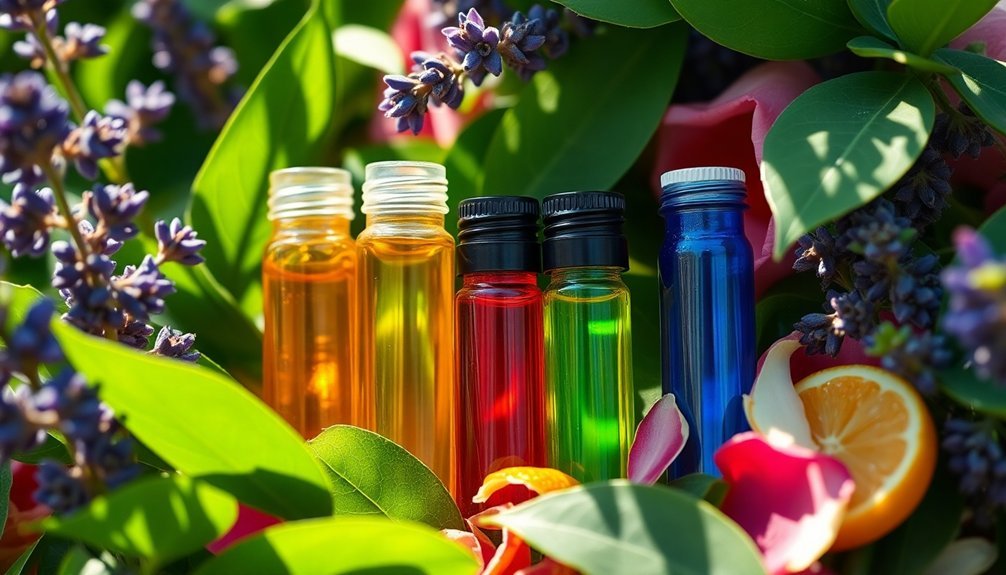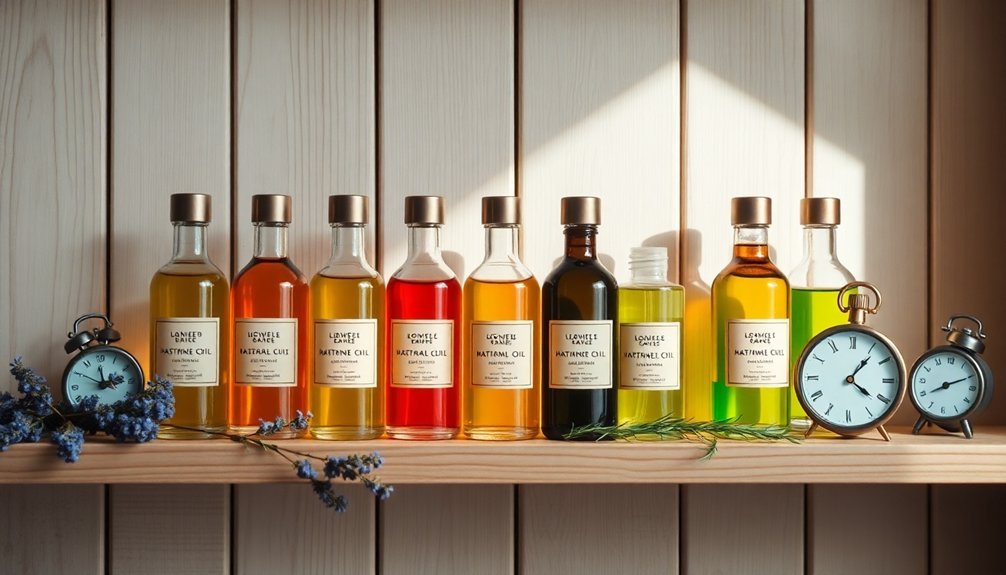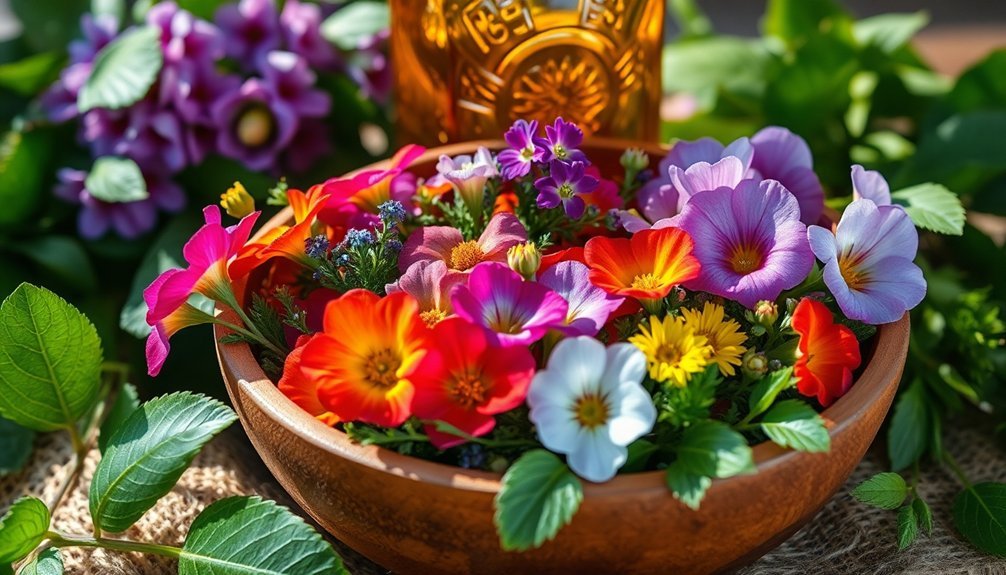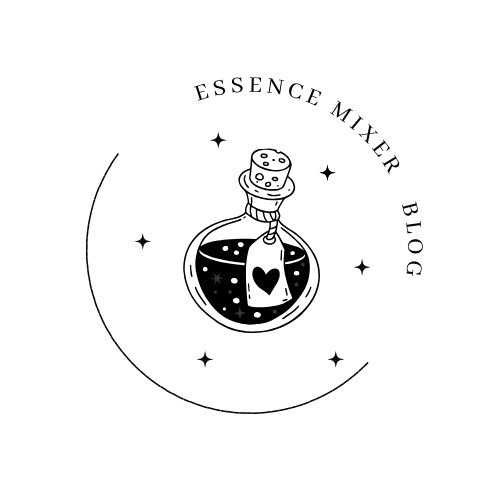Natural perfume oils require careful attention to safety and quality. You'll want to choose blends with 20-40% pure essence diluted in non-comedogenic carrier oils like jojoba or sweet almond. Keep concentrations at 2-3% for adults, and always perform a 24-hour patch test before use. Store your oils in dark containers away from heat and light to maintain potency. The journey into natural fragrances reveals a world of sustainable, therapeutic benefits waiting to be discovered.
Essential Components of Natural Perfume Oils

Three key characteristics define natural perfume oils: their concentrated formulations, sustainable sourcing, and personalized application methods. When you're selecting fragrance oils, you'll notice they contain 20-40% pure essence, markedly higher than traditional perfumes, ensuring longer-lasting wear on your skin.
These oils prioritize natural ingredients from sustainable sources, eliminating harmful synthetics like phthalates and parabens that can aggravate sensitive skin or cause hormonal disruptions.
You'll find them packaged in convenient rollerballs or droppers, allowing precise application and easy transport.
What makes these perfume oils truly special is their ability to work with your unique body chemistry. As you wear them throughout the day, they evolve into personalized scents while delivering complex aromatic profiles derived from essential oils and botanical extracts.
Understanding Carrier Oil Safety Ratios
When creating your natural perfume oils, you'll need to follow proper dilution ratios to guarantee safety, with most adults requiring a 2-3% dilution (12 drops per ounce of carrier oil).
You should reduce this ratio to 1% (6 drops per ounce) if you have sensitive skin, or 0.5% (3 drops per ounce) for children and elderly individuals.
Before applying your diluted perfume oil blend to larger areas, always perform a patch test with carrier oils like jojoba, sweet almond, or coconut oil to check for any adverse reactions.
Essential Oil Dilution Guidelines
Safe dilution of essential oils stands as a critical foundation for creating natural perfumes that won't irritate your skin. You'll need to follow specific dilution ratios to guarantee your skin scent remains both safe and effective.
| User Group | Recommended Ratio | Drops per Oz |
|---|---|---|
| Adults | 1-2% | 6-12 drops |
| Children | 0.5-1% | 3-6 drops |
| Pregnant/Nursing | 1% | 6 drops |
Before applying your diluted blend, always perform a patch test to check for sensitivities. If you're working with citrus-based essential oils, remember they can make your skin more sensitive to sunlight. It's especially important to dilute these properly and avoid sun exposure afterward. When in doubt about specific oils or ratios, particularly if you're pregnant or nursing, consult your healthcare provider first.
Common Carrier Oil Percentages
Carrier oils form the backbone of any natural perfume formulation, making up 70-90% of your final blend. This high percentage guarantees your essential oils are properly diluted and safe for skin application.
You'll find the remaining 10-30% consists of essential oils, which deliver the fragrance and therapeutic properties you're seeking.
When selecting carrier oils for your natural perfumes, focus on non-comedogenic options that match your skin type. Popular choices include jojoba, sweet almond, and fractionated coconut oil. Each offers distinct benefits for different skin sensitivities.
For ideal safety, keep your essential oil concentration at 2% or lower, especially if you have sensitive skin. This careful balance between carrier oils and essential oils helps prevent skin irritation while maintaining the perfume's effectiveness.
Safe Mixing Ratios Chart
Three essential ratios form the foundation of safe natural perfume blending: 1-2% for adults, 0.5-1% for children, and 0.5% or less for pregnant women.
To create safe fragrances, you'll need to measure carefully – for adults, use 6-12 drops of essential oils per ounce of carrier oils.
If you're mixing for children, reduce the concentration to 3-6 drops per ounce. Pregnant women should use even less, staying at 3 drops or fewer per ounce of carrier oil.
For those with sensitive skin, stick to a 1% dilution to prevent irritation.
Before applying your blend to larger areas, always perform a patch test. This simple precaution helps you avoid potential skin reactions and guarantees you're using the right ratio for your specific needs.
Beneficial Base Notes for Skin-Safe Blends
Base notes form the foundation of any well-crafted natural perfume oil, with options like sandalwood, vanilla, and amber offering both aromatic depth and skin-friendly benefits.
When you're creating skin-safe blends, you'll want to incorporate these long-lasting base notes to anchor your natural fragrance while ensuring skin compatibility.
To maximize both safety and effectiveness, combine your chosen base notes with carrier oils like jojoba or sweet almond oil.
You'll find that essential oils such as patchouli and vetiver work exceptionally well as base notes, providing grounding properties while enhancing your blend's overall profile.
These natural base notes don't just balance volatile top notes – they help create a smoother fragrance evolution on your skin.
Top Notes That Meet Safety Standards

While exploring safe top notes for natural perfumes, you'll discover an array of citrus and herbal options that meet stringent safety standards. You can trust ingredients like bergamot, lemon, and wild orange, which are sustainably sourced and free from synthetic additives commonly found in conventional fragrances.
When selecting natural fragrances, look for brands that prioritize clean ingredients and transparency in their sourcing practices.
You'll find that top notes derived from organic fruits and herbs not only comply with safety standards but also provide authentic, crisp scents. These elements typically undergo careful extraction processes to maintain their purity and effectiveness.
Proper Dilution Methods for Essential Oils
Properly diluting essential oils stands as a cornerstone of safe natural perfumery. You'll need to mix your essential oils with a carrier oil like jojoba or fractionated coconut oil to prevent skin reactions and sensitization.
For most adults, stick to a dilution ratio of 2-3%, which means adding 12-18 drops of essential oil per ounce of carrier oil. If you're pregnant, have sensitive skin, or are creating a blend for children, reduce this to a 1% dilution (6 drops per ounce).
Always store your diluted blends in glass containers, as plastic can react with the oils and compromise their quality.
Before applying your diluted blend more extensively, don't skip the patch test – apply a small amount to your skin and watch for any adverse reactions.
Storage and Shelf Life Considerations

To maximize the lifespan of your natural perfume oils, you'll need to implement proper storage practices. Unlike traditional perfumes, these concentrated formulations can maintain their potency longer when stored correctly.
| Storage Factor | Impact on Longevity | Best Practice |
|---|---|---|
| Temperature | High heat degrades oils | Store in cool place |
| Light Exposure | UV rays alter composition | Use dark containers |
| Air Contact | Oxidation affects quality | Keep bottles sealed |
| Container Type | Affects preservation | Choose airtight glass |
| Duration | Influences potency | Use within 2-3 years |
While proper storage can extend your perfume oils' shelf life beyond traditional fragrances, you'll want to monitor their scent profile regularly. When you notice any changes in the original fragrance or a significant decrease in potency, it's time to replace them, regardless of storage conditions.
Patch Testing and Sensitivity Guidelines
Before applying your new natural perfume oil, you'll need to perform a patch test on a small area of clean skin, waiting 24 hours to check for any adverse reactions.
Watch for warning signs like redness, itching, swelling, or burning sensations, which indicate you should discontinue use immediately.
If you're prone to allergies or have sensitive skin, it's crucial to consult with a dermatologist first and carefully review the ingredient list for potential triggers.
Allergy Test Best Practices
Safety should be your top priority when trying new natural perfume oils, which makes patch testing an essential first step.
Before applying any new perfume oil extensively, you'll need to conduct a proper allergy test on a small patch of your inner forearm where the skin is clear and healthy. Wait 24 hours to monitor for any adverse reactions.
If you've had fragrance sensitivities before, always review the ingredients carefully and consider consulting a healthcare professional first.
Here's what you need to remember:
- Choose a clean, irritation-free area for your patch test
- Stop using the product immediately if you notice redness, swelling, or irritation
- Don't skip the 24-hour waiting period, even if the initial application feels fine
For extra precaution, those with known allergies should consult a dermatologist before trying new perfume oils.
Skin Reaction Warning Signs
While natural perfume oils can be gentler than synthetic fragrances, understanding potential skin reactions remains essential for safe use. When applying your patch test, you'll need to monitor your skin carefully for warning signs over 24 hours.
Watch for immediate or delayed reactions, including redness, swelling, itching, or burning sensations on your skin. If you notice any of these symptoms, wash the area thoroughly with soap and water and discontinue use of the fragrance.
The concentration of essential oils in your perfume can greatly impact sensitivity, particularly if you have delicate skin.
If you've experienced previous allergic reactions to fragrances or have sensitive skin, don't hesitate to consult a dermatologist before trying new natural perfume oils. They can provide guidance tailored to your specific skin concerns.
Sustainable Sourcing of Raw Materials

Sustainable sourcing lies at the heart of natural perfume production, where ethical practices and environmental responsibility merge to create authentic fragrances. When you're choosing your natural perfume oils, look for brands that prioritize organic farming and transparent essential oils sourcing. These practices guarantee you're getting pure, high-quality fragrances while supporting environmental conservation.
- Check for eco-friendly packaging made from recycled glass and biodegradable materials.
- Look for fair trade certifications that guarantee farmers receive proper compensation.
- Research the brand's sourcing methods to ascertain they use reputable essential oil suppliers.
You'll find that sustainably sourced perfumes not only protect our planet but also deliver a more genuine scent experience. The combination of ethical practices and quality ingredients creates fragrances that are both environmentally conscious and authentically aromatic.
Therapeutic Benefits of Safe Oil Combinations
Beyond their enchanting aromas, natural perfume oils offer powerful therapeutic benefits through carefully crafted combinations of essential oils. When you choose blends containing natural and organic ingredients, you'll experience more than just a lovely scent.
Lavender and chamomile combinations can help reduce your stress levels, while citrus-based blends energize your mind and boost your mood.
These therapeutic properties extend beyond mental benefits. You'll find that natural perfume oils are gentler on your skin compared to synthetic alternatives, making them ideal if you have sensitivities.
The careful selection of oils like ylang-ylang and bergamot supports your emotional well-being through aromatherapy principles. By incorporating these mindfully created combinations into your daily routine, you're not just wearing a fragrance – you're embracing a holistic approach to wellness.
Frequently Asked Questions
What Is the Best Oil for Natural Perfume?
You'll find Malin+Goetz Dark Rum oil is your best choice, with its high 20-30% fragrance concentration and sophisticated scent. It's long-lasting, natural, and perfect for daily wear or special occasions.
Do Professional Perfumers Use Essential Oils?
Yes, professional perfumers frequently use essential oils in their creations. You'll find they blend them with synthetic ingredients to create complex fragrances, valuing essential oils for their natural depth and authentic aromatic qualities.
Do Natural Fragrance Oils Exist?
Yes, you'll find natural fragrance oils do exist. They're derived from plant-based sources like essential oils and botanical extracts. You can purchase them as pure, concentrated scents without synthetic chemicals or harmful additives.
Are There Any Non-Toxic Fragrances?
Yes, you'll find many non-toxic fragrances on the market. Brands like Ellis Brooklyn, Maison Louis Marie, and Phlur offer safe alternatives made with natural ingredients, avoiding harmful chemicals like phthalates and synthetic dyes.
In Summary
You've now got the knowledge to create safe, natural perfumes that align with expert recommendations. Remember to always follow proper dilution ratios, conduct patch tests, and store your blends correctly. Whether you're crafting perfumes for therapeutic benefits or simply personal enjoyment, stick to sustainable ingredients and trusted carrier oils. When you work with nature's essences responsibly, you'll create beautiful, skin-safe fragrances that last.





Leave a Reply